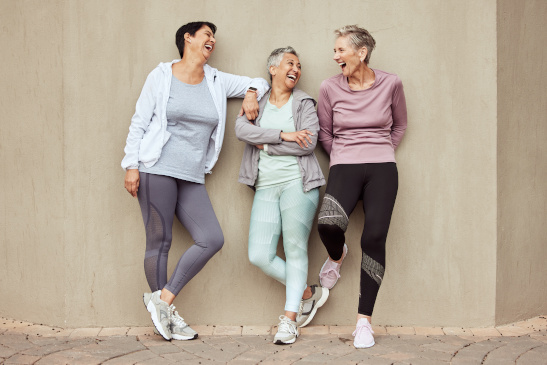The Health Benefits of Exercise

Exercise counteracts most health risk factors, whereas lack of exercise promotes them. Whether we stay healthy depends largely on whether we exercise throughout our lives.
How exercise affects the body
The following table shows how exercise or lack of exercise affects the body and organ systems.
| Influence of exercise on | Movement | lack of exercise |
|---|---|---|
| energy turnover | rises | sinks |
| body weight (with constant calorie intake) | decreases | increases |
| cardiovascular system | becomes more efficient | becomes weaker |
| Endurance | improves | worsens |
| blood pressure | sinks | rises |
| lipid metabolism | improves | worsens |
| total cholesterol | sinks | rises |
| LDL cholesterol | sinks | rises |
| HDL cholesterol | rises | sinks |
| triglycerides | sink | climb |
| sugar metabolism | improves | worsens |
| insulin levels | sinks | does not sink |
| blood sugar levels | sinks | does not sink |
| musculoskeletal system | becomes more efficient | becomes weaker |
| muscle strength | improves | worsens |
| bone density | increases | decreases |
| support function, stability | improves | worsens |
| mobility, resilience of the joints | increases | decreases |
| immune system | improves | worsens |
| brain functions | improve | worsen |
| cerebral blood flow | improves | worsens |
| formation of new nerve cells | is promoted | is not funded |
| psyche | antidepressant effect | no antidepressant effect |
Further information on the scientifically proven health benefits of regular physical activity – from infancy to old age – can be found in the Austrian exercise recommendations of the Healthy Austria Fund.
You may also like: An active lifestyle – 10 benefits of physical activity
Exercise promotes health
Exercise, body weight and energy metabolism are all connected: Energy metabolism has a key influence on the health and fitness of the entire body because it affects most of the other known risk factors, e.g. body fat percentage (waist circumference), bone density, insulin sensitivity, blood lipids and blood pressure. Strength and endurance, on the other hand, are fundamental requirements for physical performance.
From around the age of 35, the body’s performance begins to decline due to natural aging processes. As we get older, the risk of health problems therefore increases. Physical inactivity causes or promotes these deterioration processes. Sufficient exercise and targeted training help to reduce the risk factors for disease and to grow older healthily.
Certain effects of exercise can occur after a short time, for example, muscle strength and fat metabolism improve in about four to six weeks after starting training. In order to reduce the risk of disease and to live as long as possible in good health, however, exercise must be done regularly, in the right amount and throughout one’s life.
Exercise reduces the risk of disease
Studies by the World Health Organization (WHO) and the US Department of Health and Human Services , among others , have shown that exercise reduces the risk of many common and often chronic diseases and injuries. These include:
- Cardiovascular diseases (e.g. heart attack, stroke or high blood pressure)
- overweight and obesity
- metabolic syndrome
- type 2 diabetes
- Cancer (especially colon, lung, breast, uterine, stomach, esophagus, kidney, bladder and prostate cancer)
- depression
- dementia
- infectious diseases
- hip fractures
- falls
Therapy and rehabilitation: How exercise works
Exercise can help to heal many illnesses or alleviate symptoms if it is used in a targeted manner, similar to medication. The prerequisite for targeted use is knowledge of which physical effects exercise can trigger and why. In other words: what dose of exercise causes which reaction in the body?
Different training measures, e.g. training motor skills such as endurance, strength, flexibility or coordination, have different effects on the body. The severity of a patient’s illness or their physical fitness also influence the success of an exercise measure. These factors are taken into account when a doctor prescribes exercise in order to be able to use exercise in a targeted manner in therapy and rehabilitation, e.g. exercise therapy .



